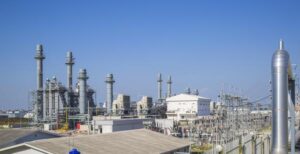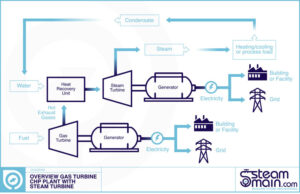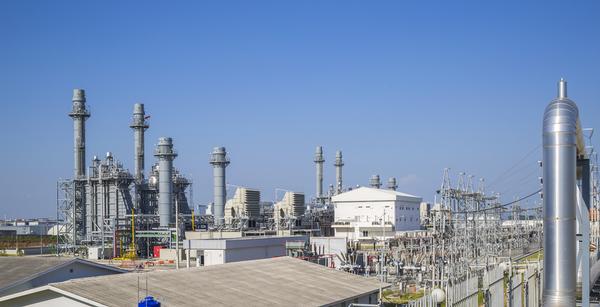There are many power plants across the globe that use gas turbines to generate electricity. Steam plays an important part in the production of electricity on these sites, including the use of steam injection into the gas turbine itself.

Whilst Sir Frank Whittle, is hailed as the father of jet propulsion and the contribution he made to the development of the industrial gas turbine was significant, (his focus was in the field of aircraft propulsion however) there is no doubt that the Brown Boveri Company (BBC) in Switzerland with their 4,000 KW Neuchatel machine can be credited with the first practical industrial gas turbine.
During development work on an axial flow compressor for use in a cracking process for oil, Brown Boveri realised that the compressor, combined with a combustor, and turbine provided for a workable gas turbine, which could be turned to power production. This was the event that led Brown Boveri to produce a gas turbine that was installed at Neuchatel in Switzerland for stand by service in 1939. The Neuchatel gas turbine had an output of 4,000 KW and an efficiency of approximately 17 percent.
The Brown Boveri company, with the merger with ASEA, changed its name to ABB in 1988. In 1999 the ABB turbine business was taken over by Alstom Power.
In the 1960s Total Energy became popular. Today this is better known as Combined Heat and Power (CHP) and in some parts of the World as Cogeneration. These schemes usually mean the combined production of electricity and heat for process or other uses. Today Cogeneration has been extended to mean the combined production of electricity and heat or cooling; and occasionally “Trigeneration”.
As long ago as 1956 Ruston installed a turbine in a combined heat and power scheme in a large shopping complex in Little Rock, Arkansas, USA. Over the years the application of gas turbines to combined heat and power/cogeneration has grown enormously, and this is where steam plays its part.
Combined Cycle
A combined cycle power plant is a plant that produces electricity from gas and steam turbines. The gas turbine drives an electrical generator and the exhaust gas energy from the gas turbine is used to generate steam in a heat recovery steam generator (HRSG) which then produces electricity from a steam turbine. The combination of the heat recovery steam generator and the steam turbine has enabled the gas turbine to leap to prominence as a primary power generator.
At the time of the emergence of the industrial gas turbine in 1939 the thermal efficiency was 17-18 percent. When compared with a same period coal fired steam cycle power station, with efficiencies of 25-26 percent, the results were not favourable. Over the following years the steam cycle thermal efficiency continued to improve always keeping ahead of the simple cycle gas turbine until around 2000 when advanced class gas turbines became operational. However this race between the gas turbine and the conventional steam cycle efficiency was effectively halted in the 1960s when the combined gas turbine steam turbine cycle started pushing plant thermal efficiencies over 40% and beyond.
The CCGT cycle has made steady progress and together with CCGT the gas turbine has overtaken the conventional cycle reaching unbelievably high cycle thermal efficiencies. In the UK the first CCGT was the Roosecote Station in Cumbria commissioned in 1991 producing 224,000 KW with a thermal efficiency of 49%.
Cogen
Similar to the combined cycle, where a gas turbine drives an electrical generator and the exhaust gas energy from the gas turbine is used to generate steam in a heat recovery steam generator (HRSG). Instead of a steam turbine, however the steam is used for process requirements. Typical cogeneration applications include pulp and paper plants, chemical production and district heating programs.

Gas turbine steam injection
In a cogen application some of the the steam generated in the HRSG is fed back to the gas turbine. This is done for power augmentation or to reduce the NOx levels.
This process consists of injecting superheated steam into the head end of the combustor of the gas turbine to reduce NOx emissions. The steam provides a thermal heat sink in the combustor that lowers the temperature reducing the creation of thermal NOx.
For increased power, superheated steam is injected into the combustors and power turbine to increase the mass flow, which then results in increased power output.
The amount of steam that can be injected into the gas turbine is dependent on the model type and exact configuration. Usually, the maximum amount of steam that can be injected is in the range of 5-20 percent of the air mass flow.
There are several advantages using a steam injected gas turbine in connection to Cogen application:
- Higher efficiency than a gas turbine without steam injection
- The steam injection rate into the turbine can be varied which means that the amount of process steam also can be varied, giving a very flexible installation
- Lower capital cost than a combined cycle plant
- Occupies less space than both a combined cycle plant
However, there are some drawbacks:
- A steam injection gas turbine consumes valuable treated water. If no flue gas condensing is performed, the water is lost in the atmosphere. Some of the water content in the gases can be recovered if flue gas condensing is employed however.
- The steam injection gas turbine cannot reach the high electrical efficiency of a combined cycle plant since water in vapour form leaves in the stack and thus the water vaporization (latent) heat of the gas/steam flow is lost.

